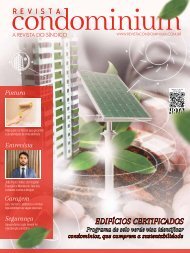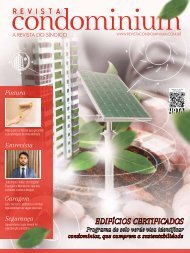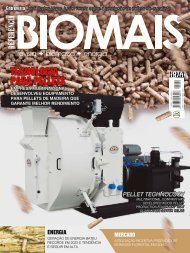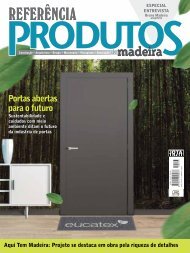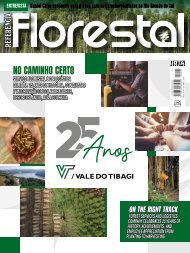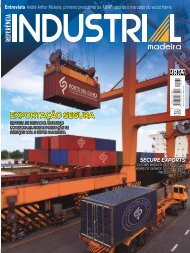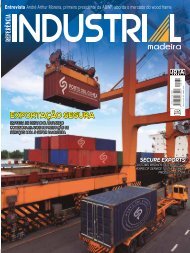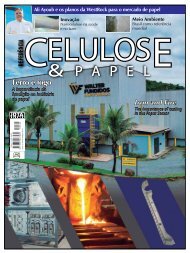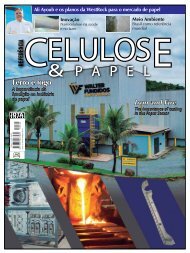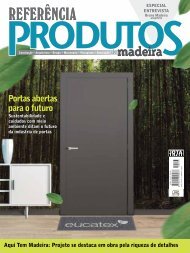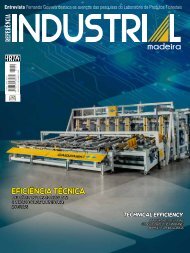You also want an ePaper? Increase the reach of your titles
YUMPU automatically turns print PDFs into web optimized ePapers that Google loves.
A R T I G O<br />
Objetivo foi conhecer a visão<br />
dos produtores florestais sobre<br />
o programa de fomento, suas<br />
principais dificuldades e seu<br />
histórico profissional<br />
cendo. Porém, um dos grandes gargalos do desenvolvimento<br />
das indústrias de base florestal, seja para<br />
celulose, serraria ou carvão vegetal, está no seu<br />
suprimento de matéria-prima, ou seja, a madeira.<br />
De acordo com Soares (2006), o fomento florestal<br />
é uma das estratégias das empresas para garantir<br />
seu suprimento de matéria-prima. O interesse das<br />
indústrias é reduzir a imobilização de recursos em<br />
terras e capital. Assim, o fomento florestal é importante<br />
para o setor, além de estar contribuindo para o<br />
desenvolvimento local (Valverde, 2003).<br />
Nos contratos de fomento das empresas florestais,<br />
especificamente celulose e papel, são<br />
repassados aos produtores de mudas, fertilizantes,<br />
defensivos, recursos financeiros e assistência técnica<br />
(Oliveira, 2003).<br />
A principal dúvida sobre investimentos em programas<br />
de fomento florestal é: Podemos confiar a<br />
produtores fomentados o suprimento de madeira?<br />
Entre as alternativas para responder a essa questão,<br />
uma está em uma abordagem que possa refletir<br />
sobre os elementos que contribuem para a relação<br />
de confiança entre produtores e empresas fomentadoras.<br />
A corrente teórica denominada NEI (Nova<br />
Economia Institucional) possui como um dos seus<br />
elementos de análise a confiança. A NEI propõe<br />
uma discussão a respeito da análise do ambiente<br />
econômico, colocando o papel da estrutura e da<br />
organização política e social na determinação dos<br />
acontecimentos econômicos.<br />
Os custos antes e depois da formulação e execução<br />
dos contratos são abordados na NEI. Também,<br />
realizam-se reflexões sobre o papel das instituições<br />
program, 98.4% of them completed their contractual<br />
obligations. Trust and trustworthiness were confirmed<br />
as existing in relationships between the pulp producer<br />
and woodlot producers. However, some factors in the<br />
woodlot development program contribute to mistrust,<br />
including the timber volume measurement system,<br />
transport costs, and the absence of a pricing policy<br />
easily understood by woodlot producers.<br />
Keywords: woodlot development programs, trust,<br />
and pulp industry<br />
1. INTRODUCTION<br />
Brazil has been one of the Countries where significant<br />
investments in the Forestry Sector have taken<br />
place. However, one of the major bottlenecks in the<br />
development of the forest-based industry, whether for<br />
pulp, sawmill, or charcoal production, is the supply of<br />
raw material, that is, timber.<br />
According to Soares (2006), the promotion of<br />
forest development programs is one of the strategies<br />
forest product companies use to ensure their supply<br />
of raw materials. The interest of producers is to reduce<br />
the immobilization of resources on land and capital.<br />
Thus, the promotion of woodlots is important for the<br />
Sector, besides contributing to local development<br />
(Valverde, 2003).<br />
In the contracts for the forest development programs<br />
sponsored by forest product companies, specifically<br />
pulp and paper producers, the forest product<br />
company supplies seedlings, fertilizer, pesticides and<br />
herbicides, financial resources, and technical assistance<br />
to the woodlot producers (Oliveira, 2003).<br />
The main question about investments in forest<br />
development programs is: Can we trust the woodlot<br />
producers to supply the timber harvested? Among the<br />
alternatives to answer this question, one is an approach<br />
that can reflect on the elements that contribute to<br />
the trust relationship between the woodlot producers<br />
and sponsoring companies.<br />
The current theory, called New Institutional<br />
Economics (NIE), has trust (credible commitment) as<br />
one of its analysis elements. NIE proposes a discussion<br />
about the analysis of the economic environment, placing<br />
the role of the structure and political and social<br />
organization in determining economic events.<br />
The costs before and after the formulation and<br />
execution of contracts are addressed in the NIE. Also,<br />
reflections are made on the role of economic and<br />
34



